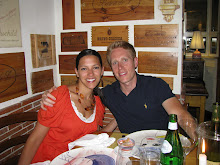
Italian Bread? Isn't that a generalization? No, I'm talking about the kind of bread my grandfather used to ritually go to the store for in the morning. The kind he would take out of the long paper bag, ripping off the ceremonial first chunk. Sliced and toasted in the morning with butter, used to make a sandwich at lunch, zopped in sauce at dinner. As long as I can remember my grandfather stocked and traveled with this kind of loaf, which is why this post is in his memory.
Good bread, I've found, takes time more than anything. It's not so much about technique or ingredients, but allowing the dough to properly ferment and develop the natural flavors that occur after flour and water are mixed.
For that reason most of the bread I make takes a couple of days. I don't consider recipes for any rustic loaves that give a total preparation time of 3 hours, for example. To me that signals that they're jacking up the yeast content to reduce rising time, which leads to over-yeasted bread that doesn't taste right or have any shelf life. Some yeastiness is good, yes, but what you're tasting in a good bread is the result of fermentation of all the ingredients, rather than the added rising agent itself.
So this italian bread formula starts with a pre-ferment, a biga, that gets made the day before baking, and builds flavor overnight in the fridge. It's added into a new batch of dough several hours prior to baking, kick starting the second dough and giving it a more complex flavor.
In terms of technique for this bread and my other favorites (ciabatta, focaccia, baguette), it's key not to over-flour. When people knead, especially by hand, they tend to keep adding flour to avoid the dough becoming a sticky mess. That increases density, and the aforementioned breads need high amounts of hydration to produce the irregular air pockets and chewiness we appreciate. I knead in an electric mixer and err on the side of tacky to wet and sticky.
I have to give credit to the Bread Baker's Apprentice by Peter Reinhart, a comprehensive guide to the art of baking by time-honored techniques. It purposely avoids shortcuts and works on formulas that I have found yield very good results at home. Most importantly, it makes it possible for a novice to become a good baker.
This formula includes diastatic malt powder, which is used to make the crust browner and thicker so that it kind of snaps when cut or torn off. It's not molecular gastronomy, just a dough enhancer that is totally natural (made by grinding toasted wheat berries), and it definitely improves the look and texture of the crust in this formula, as well as extending the shelf life. It is always available at King Arthur's online store, $3.95 for a lb., way more than you'll use in a year.
I opt for instant yeast for all formulas that call for added yeast. Unlike dry active or fresh, this yeast can be stored in the freezer for over a year and does not need to be primed in water, just mixed in with dry ingredients. It's also available from King Arthur and is not expensive--for $6 you'll get enough to make 96 breads.
I use a Kitchen Aid stand mixer to mix and knead most of the dough I make. It's not ideally suited to making bread dough because the shape of the mixing bowl and the lack of counter rotation mean the mass of dough sometimes just gets wound up and spins around uselessly. I have found though that manipulating the elevation of the mixing bowl (manually moving the lever on the right side that adjust the height of the bowl) enables me to get the dough to stretch and work to good effect. So while it's mixing I periodically raise and lower the bowl this way to allow gravity to pull the dough off the hook and stretch, then reattach itself. It sounds laborious, but it's easier than kneading by hand. The mixing bowl is also better at working additional water into the dough than hands--flour too but I almost never add more flour.
In the next post I will provide the formula for the bread itself.
John D. Zeoli 1924-2010




No comments:
Post a Comment